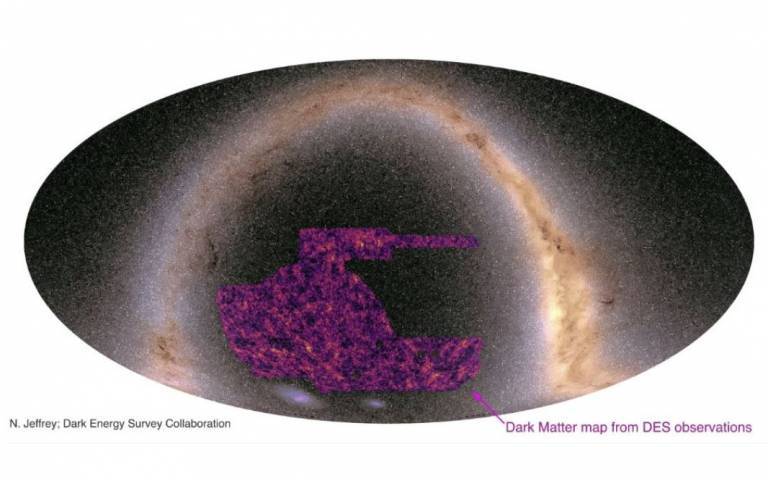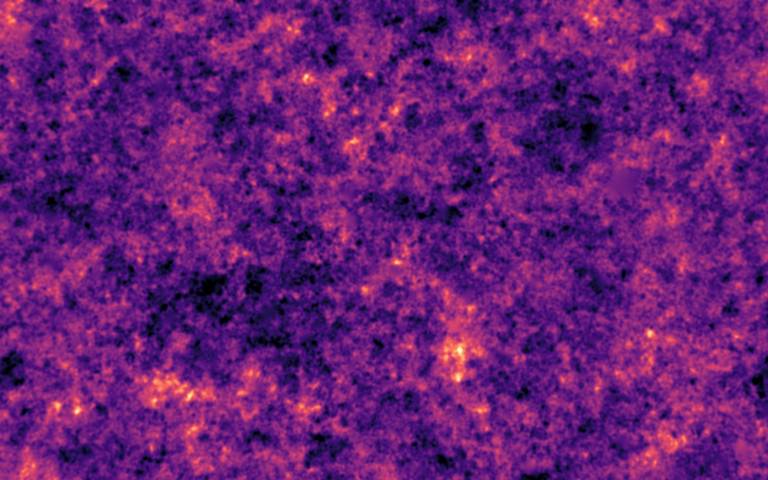Dark matter mapped using light from 100 million galaxies
27 May 2021
The largest ever map of dark matter – invisible matter thought to account for 80% of the total matter of the Universe – has been created by a team co-led by UCL researchers, as part of the international Dark Energy Survey (DES).

As matter curves space-time, astronomers are able to map its existence by looking at light travelling to Earth from distant galaxies; if the light has been distorted, this means there is matter in the foreground, bending the light as it comes towards us.
The team used artificial intelligence methods to analyse images of 100 million galaxies, looking at their shape – spots of light made up of 10 or so pixels – to see if they have been stretched.
The new map, a representation of all matter detected in the foreground of the observed galaxies, covers a quarter of the sky of the Southern Hemisphere. It is described in a new paper posted on the DES website and to be published in the Monthly Notices of the Royal Astronomical Society.
Co-lead author Dr Niall Jeffrey (both at École Normale Supérieure, Paris, and UCL Physics & Astronomy) said: “Most of the matter in the Universe is dark matter. It is a real wonder to get a glimpse of these vast, hidden structures across a large portion of the night sky. These structures are revealed using the distorted shapes of hundreds of millions of distant galaxies with photographs from the Dark Energy Camera in Chile.
“In our map, which mainly shows dark matter, we see a similar pattern as we do with visible matter only– a web-like structure with dense clumps of matter separated by large empty voids.
“Observing these cosmic-scale structures can help us to answer fundamental questions about the Universe.”
Since the 1930s, astronomers have suspected there is more material in the Universe than we can see. Dark matter, like dark energy, remains mysterious, but its existence is inferred from galaxies behaving in ways not predicted – for instance, the fact that galaxies stay clustered together, and that galaxies within clusters move faster than expected.
Co-author Professor Ofer Lahav (UCL Physics & Astronomy), chair of the DES UK consortium and co-Director of UCL’s Centre for Doctoral Training Centre in Data Intensive Science, said: “Visible galaxies form in the densest regions of dark matter. When we look at the night sky, we see the galaxy’s light but not the surrounding dark matter - like looking at the lights of a city at night.
“By calculating how gravity distorts light, a technique known as gravitational lensing, we get the whole picture – both visible and invisible matter. This brings us closer to understanding what the Universe is made of and how it has evolved. It also shows the power of artificial intelligence methods to analyse one of the largest data sets in astronomy.”

Co-author Dr Chihway Chang (University of Chicago) said: “Our map projects 3D space, extending out over seven billion light years, into a 2D representation. In our next phase of work, we will analyse tomographic maps at varying distances to build a 3D view of the Universe. These maps will also enhance our understanding of the connection between dark matter and galaxies.”
The map was created following an immense amount of careful work to measure the galaxy shapes by the DES collaboration, hosted by the US Department of Energy’s Fermi National Accelerator Laboratory (Fermilab) and involving more than 400 scientists from 25 institutions in seven nations.
The international project aims to measure the composition and growth of the Universe and to better understand dark matter and dark energy, which is thought to be driving the Universe’s accelerating expansion.
The collaboration has catalogued hundreds of millions of galaxies, using photographs of the night sky taken by the 570-megapixel Dark Energy Camera, one of the world’s most powerful digital cameras, over six years (from 2013 to 2019). The camera is mounted on a telescope at the National Science Foundation’s Cerro Tololo Inter-American Observatory in Chile. Dr Marco Gatti, of the University of Pennsylvania, a co-lead author of the dark matter paper, said: “These images provide us with the most precise ever look at the Universe’s evolution over the last seven billion years.”
New analysis of the first three years of the survey by DES scientists suggests that matter is distributed throughout the Universe in a way that is consistent with predictions in the standard cosmological model, the best current model of the Universe.
But the analysis found hints, as with previous surveys, that the Universe may be a few per cent smoother than predicted. This prediction comes from analysis of the light left over from the Big Bang (known as the cosmic microwave background, or CMB).
Dr Pablo Lemos (both UCL Physics & Astronomy and Sussex University), co-author of the new analysis paper, said: “It would be very exciting to find contradictions between galaxy surveys like DES and analyses of the CMB, as they would provide hints of new physics. This observed difference in the clustering of matter could be one such contradiction, but we will need more data to confirm it.”
Current evidence obtained through analysing the CMB suggests the Universe at present is made up of approximately 5% ordinary, visible matter, 25% dark matter, and 70% dark energy. DES Director and spokesperson Professor Rich Kron, who is a Fermilab and University of Chicago scientist, said: “DES seeks to illuminate the natures of dark matter and dark energy by studying how the competition between them shapes the large-scale structure of the Universe over cosmic time.”
In the UK the study received funding from the Science and Technology Facilities Council (STFC) and the Higher Education Funding Council for England. Other funding for DES projects has been provided by the U.S. Department of Energy, the U.S. National Science Foundation, the Ministry of Science and Education of Spain, the National Center for Supercomputing Applications at the University of Illinois at Urbana-Champaign, the Kavli Institute of Cosmological Physics at the University of Chicago, Funding Authority for Funding and Projects in Brazil, Carlos Chagas Filho Foundation for Research Support of the State of Rio de Janeiro, the Brazilian National Council for Scientific and Technological Development and the German Research Foundation.
Links
- Dark Energy Survey
- Professor Ofer Lahav’s academic profile
- UCL Physics & Astronomy
- UCL News story: Survey of the sky maps 700 million astronomical objects
- “The Dark Energy Survey: The Story of a Cosmological Experiment”
- École Normale Supérieure, Paris
Image
Credit: N. Jeffrey / Dark Energy Survey collaboration.
The lightest areas of the map show the regions where dark matter is most dense. These correspond to superclusters of galaxies. The dark, almost black patches are cosmic voids, the large empty spaces in between clusters of galaxies. The map has been superimposed on an image of the Milky Way. Bottom picture: a close-up of the map.
Media contact
Mark Greaves
T: +44 (0)7990 675947
E: m.greaves [at] ucl.ac.uk
 Close
Close

